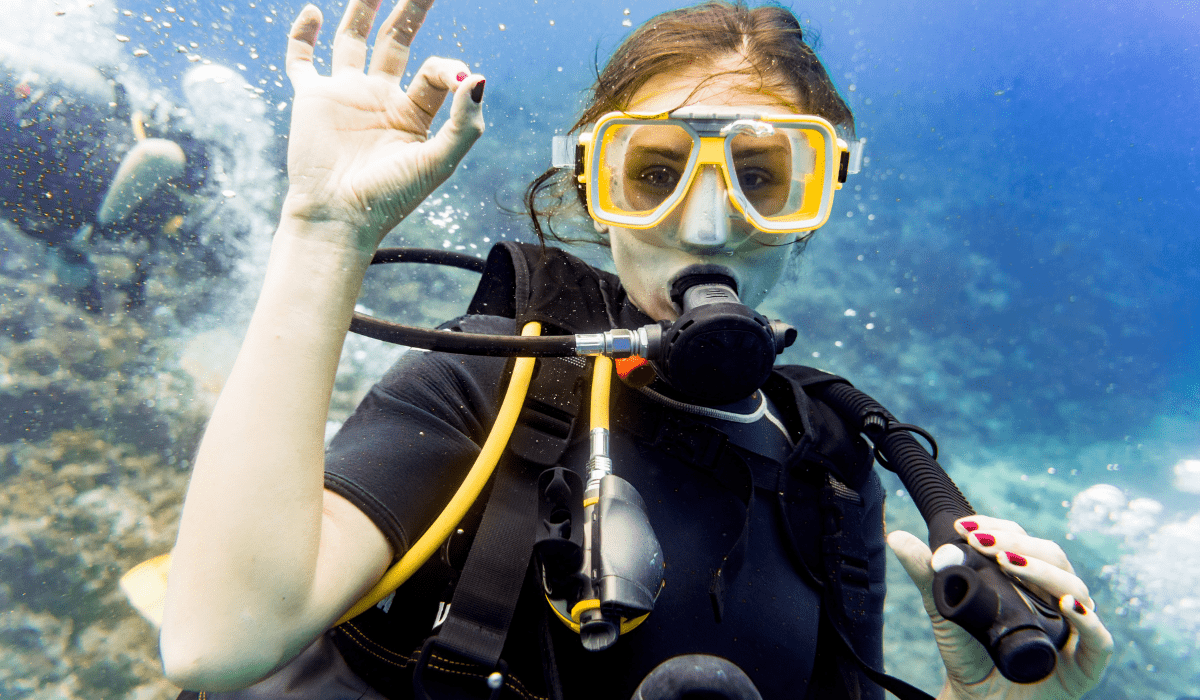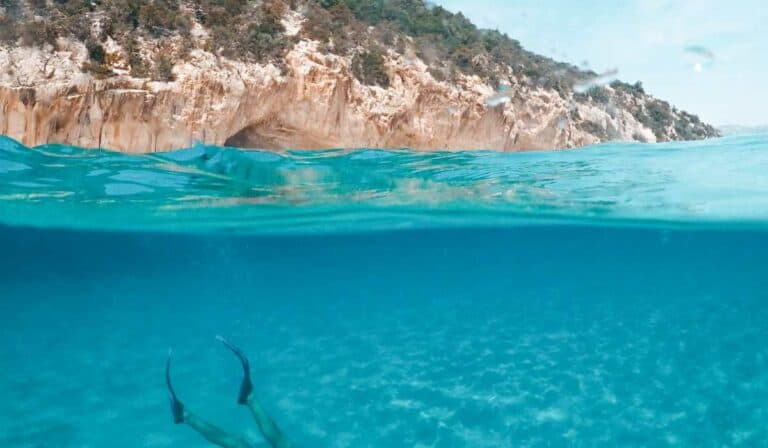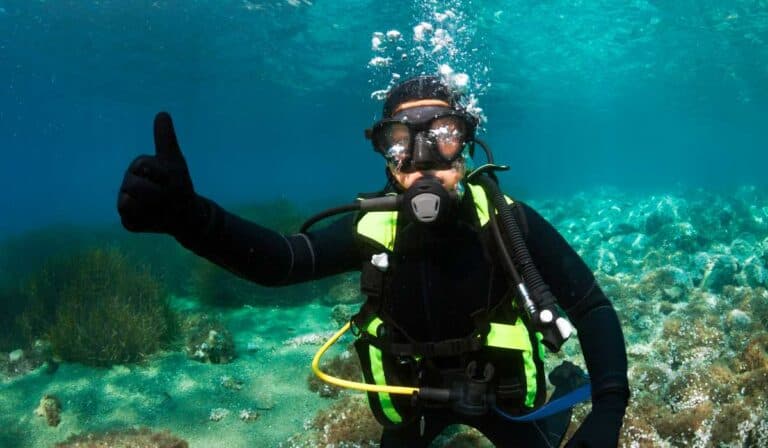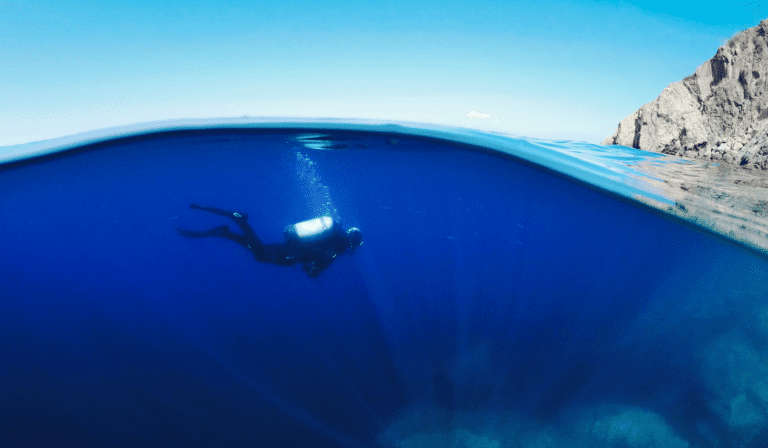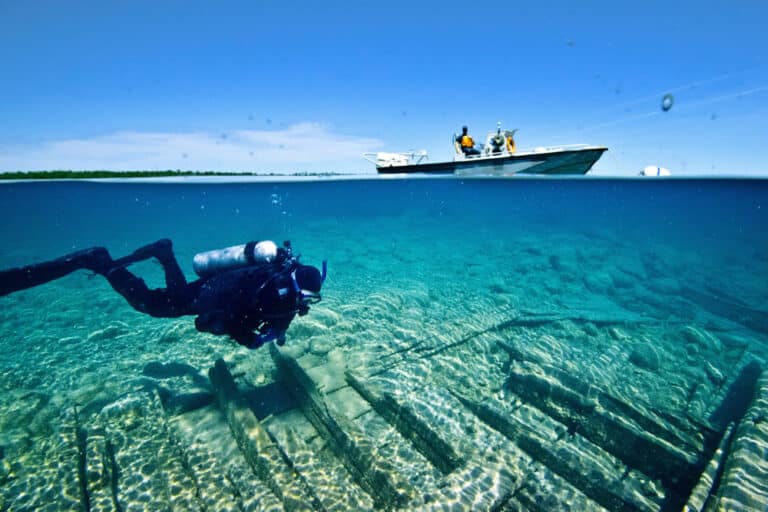A Guide To Scuba Diving in Honduras
Welcome to our comprehensive guide on scuba diving in Honduras, a hidden gem for underwater enthusiasts. As you dive into this post, we will explore the ins and outs of experiencing the breathtaking marine life found beneath the Caribbean Sea.
Our A Guide To Scuba Diving in Honduras covers essential information such as rules and regulations, best locations for diving, costs involved, safety tips, necessary gear, marine life encounters, and weather conditions. This valuable guide seeks to provide divers of all levels with the information they need for a successful and memorable underwater exploration.
So let’s dive right in and uncover the secrets of Honduras’ underwater world together!
Table of Contents
1. Rules and Regulations for Scuba Diving in Honduras
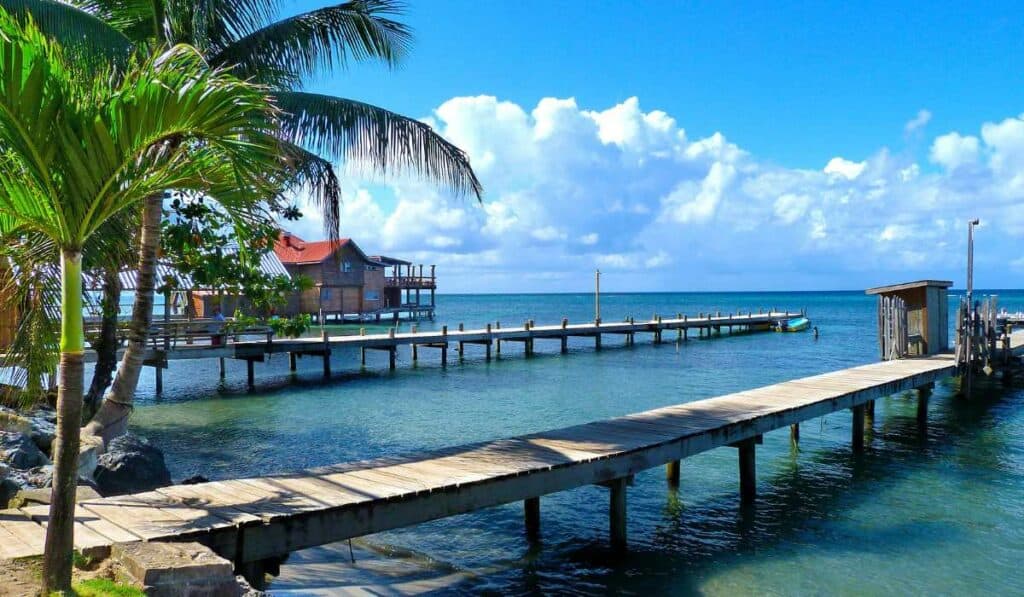
Honduras is a mecca for scuba divers, renowned for its crystalline waters, diverse aquatic wildlife, and unparalleled dive spots. Before taking the plunge into Honduras’ aquatic paradise, familiarize yourself with its scuba diving regulations.
Scuba Diving Certification Requirements
To ensure safety while exploring the depths of Honduran waters, divers must possess a valid scuba diving certification from an internationally recognized organization such as PADI or SSI. If you’re not yet certified but wish to experience the thrill of scuba diving during your trip to Honduras, consider enrolling in a beginner course like PADI Open Water Diver or SSI Basic Diver.
Dive Insurance Coverage
Prioritize safety by obtaining adequate dive insurance coverage. Dive insurance can cover medical emergencies related to decompression sickness (DCS), hyperbaric chamber treatments, evacuation costs if necessary, and even lost equipment replacement. It’s always better to be prepared when venturing into unknown territories.
National Park Entry Fees & Marine Protected Areas (MPAs)
- The Bay Islands are home to several protected areas that require visitors to pay entry fees. For example, Roatan Marine Park, a non-profit organization responsible for managing Roatan’s MPAs, requires purchasing wristbands at $10 per person annually which contributes towards conservation efforts within these zones.
- If you plan on visiting the stunning Cayos Cochinos Marine Reserve, be prepared to pay an additional entry fee of around $5 per person.
- Always respect the rules and regulations within these protected areas, including adhering to no-fishing zones, respecting wildlife, and avoiding contact with coral reefs.
Dive Safety Guidelines & Best Practices
When scuba diving in Honduras, it’s crucial to follow standard dive safety guidelines and best practices. These include:
- Never diving alone – always have a buddy or join a guided group dive.
- Maintaining proper buoyancy control to avoid damaging marine life or injuring yourself on underwater structures.
- Familiarizing yourself with local currents and conditions before entering the water.
- Carrying appropriate safety equipment such as surface marker buoys (SMBs), signaling devices, and cutting tools for emergencies.
In addition to following these rules and regulations while scuba diving in Honduras, remember that responsible tourism is key when visiting any destination. Always practice good environmental stewardship by minimizing your impact on fragile ecosystems both above and below the waterline.
To ensure a safe and enjoyable scuba diving experience in Honduras, it is important to be familiar with the applicable rules and regulations. Next, we will examine some of the prime spots for scuba diving in Honduras.
Key Takeaway:
Prior to exploring the depths of Honduras by scuba, it is imperative that you are aware of all regulations and rules. Divers must have a valid certification, obtain dive insurance coverage, pay entry fees for protected areas, and follow safety guidelines such as never diving alone and carrying appropriate equipment. Responsible tourism is also crucial for preserving fragile ecosystems both above and below the waterline.
Click here to read about Discover the 5 Best Beach Cities for Scuba Diving
2. Best Locations for Scuba Diving in Honduras
Honduras boasts an array of aquatic attractions, boasting sparkling waters, and a wide variety of sea creatures. Whether you’re a beginner or an experienced diver, there’s something for everyone at these top locations:
Roatan
Roatan, one of the Bay Islands, is known as a scuba diving paradise due to its proximity to the Mesoamerican Barrier Reef System – the second-largest barrier reef system globally. With over 100 dive sites available around Roatan, divers can explore vibrant coral reefs teeming with diverse marine life such as turtles, rays, eels, and even whale sharks during their migration season.
West End Wall & Texas
The West End Wall offers spectacular wall dives where you can encounter large schools of fish and sea turtles while drifting along with mild currents. Texas, another popular site near West End Village on Roatan Island, features massive barrel sponges and gorgonian fans inhabited by colorful macro critters like nudibranchs.
Utila
A smaller island than Roatan but equally impressive when it comes to scuba diving opportunities is Utila. This island attracts many divers seeking encounters with majestic whale sharks that frequent its waters between March and April or September through December. Other notable dive sites include Black Coral Wall – adorned with black corals – and Duppy Waters which boasts underwater caves filled with fascinating marine life.
Cayos Cochinos
For a more remote and pristine diving experience, the Cayos Cochinos archipelago is an excellent choice. This group of 13 small coral islands and cays offers untouched dive sites with vibrant corals, sponges, and diverse marine life such as nurse sharks, lobsters, sea turtles, and reef fish. Due to its protected status as a Marine Biological Reserve since 1994, Cayos Cochinos remains one of Honduras’ best-kept secrets for scuba diving enthusiasts.
In summary, Honduras has no shortage of incredible dive locations that cater to divers of all skill levels. With stunning underwater landscapes teeming with unique marine species in crystal-clear waters, it’s easy to see why this Central American gem is considered one of the world’s top scuba diving destinations.
Honduras presents a superb diving destination in Central America, boasting pristine waters and abundant aquatic life. Moving on to cost considerations for a dive trip in Honduras, let’s explore what kind of budget you’ll need.
Key Takeaway:
Honduras is a scuba diving paradise with some of the world’s best dive sites, including Roatan, Utila, and Cayos Cochinos. Divers can explore vibrant coral reefs teeming with diverse marine life such as turtles, rays, eels, and even whale sharks during their migration season while experiencing stunning underwater landscapes in crystal-clear waters.
Click here to read about Diving in the Lone Star State: The Best Places to Scuba Dive in Texas
3. Cost of Scuba Diving in Honduras
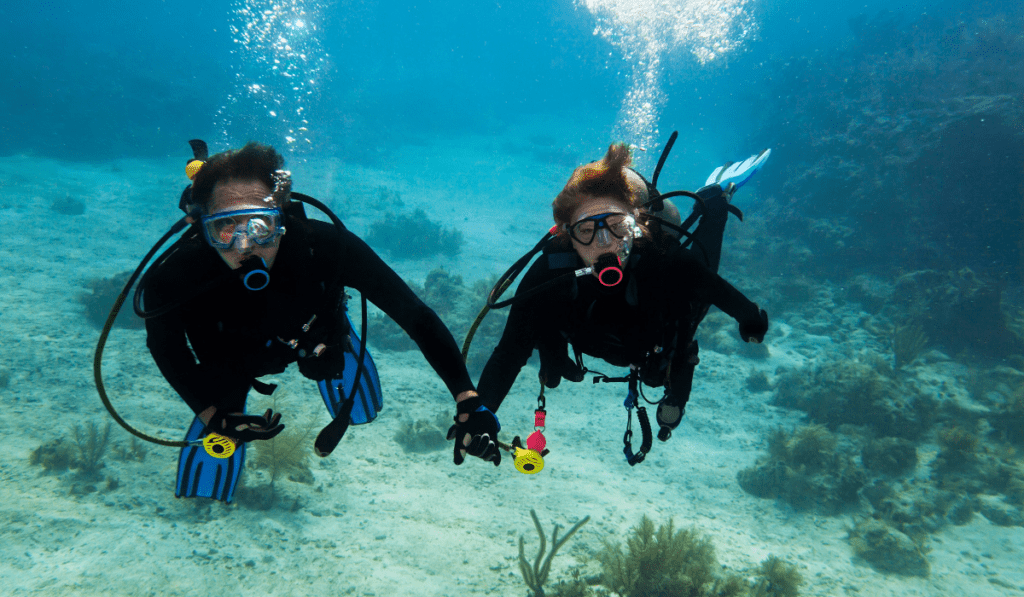
Before you dive into the depths of Honduras, it’s important to understand how much your scuba adventure will cost. The overall cost will depend on various factors such as your certification level, gear rental or purchase, and location.
Scuba Diving Certification Courses
The first step for any aspiring diver is obtaining a PADI certification. There are several levels of certifications available depending on your experience and desired skill set:
- Open Water Diver: This entry-level course typically costs between $350 – $450 USD.
- Advanced Open Water Diver: To further enhance your skills, this course ranges from $300 – $400 USD.
- Dive Master Course: For those looking to become professionals, expect to pay around $1,000 – $1,500 USD for this comprehensive training program.
Gear Rental and Purchase Costs
Renting gear is an affordable option if you don’t plan on diving frequently. However, investing in quality equipment might be more cost-effective if you intend to dive regularly. Here’s a breakdown of approximate costs for both options:
Dive Packages and Excursions Costs in Honduras
In addition to certification courses and gear expenses, you’ll also need to factor in the cost of dive packages. These vary depending on location, duration, and type of dives offered. Here are some approximate costs for popular diving spots in Honduras:
- Roatan: A two-tank boat dive can range from $80 – $100 USD per person.
- Utila: Expect to pay around $30 – $40 USD per person for a single tank shore dive.
- Guanaja & Cayos Cochinos: Liveaboard trips with multiple dives start at approximately $1,500 USD per person for a week-long excursion.
Exploring the depths of Honduras through scuba diving can be a worthwhile experience, provided you are able to afford all the required equipment and fees. To ensure your safety while scuba diving, it is important to understand some tips about safely scuba diving in Honduras before taking the plunge.
4. Tips for Safely Scuba Diving in Honduras
Scuba diving in Honduras can be an incredible experience, but it’s essential to prioritize safety during your underwater adventures. Follow these tips to ensure a safe and enjoyable dive:
Choose a Reputable Dive Operator
The first step towards a safe scuba diving experience is selecting a reliable PADI-certified dive operator. Research reviews and ask fellow divers for recommendations before booking your trip.
Become Familiar with Local Conditions
Honduras has its unique set of diving conditions that you should familiarize yourself with beforehand. This includes understanding the local currents, tides, water temperature, and visibility levels.
Dive Within Your Limits
No matter how tempting it may be to explore deeper or more challenging sites, always stay within your skill level and certification limits while scuba diving in Honduras.
Maintain Proper Communication Underwater
Understand the basic hand signals used by divers to communicate underwater effectively. Establishing clear communication with your buddy or group ensures everyone stays informed about potential hazards or changes in plans.
Pack Essential Safety Gear
- Dive computer: To monitor depth, time spent underwater, and decompression stops accurately.
- Safety sausage (SMB): A brightly colored inflatable tube that helps signal boats on the surface of your location when ascending from deep dives.
- Cutting tool: Useful for cutting entangled lines or fishing nets if needed during emergencies.
Familiarize Yourself With Emergency Procedures
Be knowledgeable about the necessary steps to take in an emergency, such as if you become separated from your dive partner or experience a medical issue, and carry a card for quick access to help. Discuss these procedures with your dive operator and always carry a card for access to emergency assistance if needed.
By following these safety tips, you’ll be well-prepared to enjoy the incredible underwater world that Honduras has to offer. From shallow reefs to wall dives, Honduras has dive sites for all levels of experience. Visit Honduras during the dry season from February to June for the best visibility and calmest waters. Some popular dive sites include the Mesoamerican Barrier Reef, Cayos Cochinos, and the El Aguila wreck.
Don’t miss the chance to see whale sharks, nurse sharks, moray eels, and even dolphin skeletons found in the Cayman Trench. With affordable diving and a variety of dive centers and shops, Honduras is a must-visit destination for scuba divers and underwater enthusiasts.
Exploring the depths of Honduras’ waters can be a safe and exciting experience if proper safety measures are taken. Before embarking on a scuba diving excursion, it is imperative to equip oneself with the right equipment for safety and enjoyment.
Key Takeaway:
To safely scuba dive in Honduras, it is important to choose a reputable PADI-certified dive operator, familiarize yourself with local conditions and stay within your skill level. Additionally, pack essential safety gear such as a dive computer and cutting tool, and know emergency procedures in case of an emergency. With these tips in mind, divers can enjoy the unique underwater world that Honduras has to offer including whale sharks and nurse sharks at popular sites like the Mesoamerican Barrier Reef or Cayos Cochinos.
5. Gear Needed for Scuba Diving in Honduras
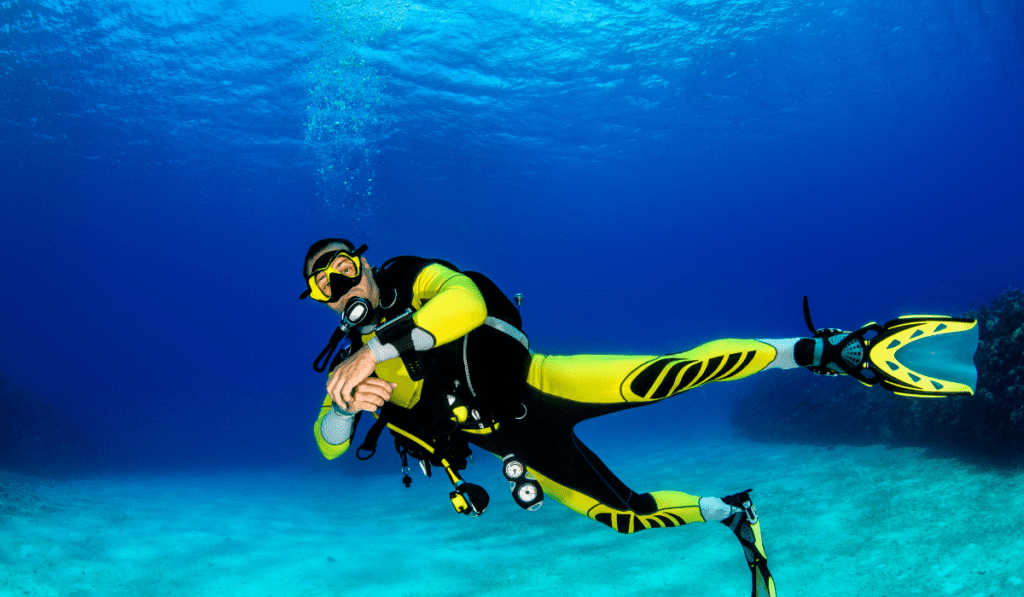
Planning a scuba diving journey in Honduras necessitates having the right equipment with you to guarantee an enjoyable and safe outing. In this section, we’ll cover the necessary equipment you should bring along or rent while diving in Honduras.
A. Personal Dive Equipment
Your personal dive equipment consists of items that are specific to your comfort and fit. It is recommended that you invest in these pieces of gear:
- Dive mask
- Snorkel
- Fins
- Booties (if using open-heel fins)
- Optional: Dive computer or watch (Note: Some dive centers may provide one for use during your dives.)
B. Rental Gear
Most dive centers will offer rental gear packages, which typically include:
- Buoyancy Control Device (BCD)
- Regulator with alternate air source and gauges
- Wetsuit (appropriate thickness for water temperature)
- Weight system (either integrated into the BCD or separate weight belt)
- Tank(s)
C. Additional Recommended Gear
While not strictly necessary, these items can enhance your diving experience in Honduras:
- Dive light (Note: Essential for night dives or exploring caves and wrecks.)
- Surface marker buoy (SMB)
- Optional: Underwater camera to capture memories of your dive adventures.
Remember, it’s essential to maintain all gear properly before and after each dive. If you’re unsure about any aspect of equipment maintenance, consult with the staff at your chosen dive center in Honduras for assistance.
Before beginning your scuba diving journey in Honduras, it is essential to make sure you have the necessary equipment and knowledge of marine life. It is critical to have knowledge of the aquatic wildlife that can be encountered while scuba diving in Honduras so you are prepared for your deep-sea journey. Next, we will discuss some of the unique creatures and plants found while exploring beneath the waves off Honduras’ coast.
6. Marine Life Found While Scuba Diving in Honduras
Honduras is home to a diverse and vibrant array of marine life, making it an underwater paradise for scuba divers. The country’s warm waters and pristine coral reefs provide the perfect environment for various species to thrive.
A. Colorful Coral Reefs
The Mesoamerican Barrier Reef System, which stretches along the coast of Honduras, offers stunning coral formations that house countless marine creatures. You’ll encounter hard corals such as brain coral, elkhorn coral, and staghorn coral alongside soft corals like sea fans and sea whips.
B. Tropical Fish Species
While exploring the depths of Honduran waters, you’ll come across numerous tropical fish species swimming among the colorful corals. Some common sightings include:
- Angelfish
- Butterflyfish
- Damselfish
- Grouper
- Parrotfish
- Sergeant majors
- Tags
- Trumpetfish
C. Large Marine Animals
In addition to smaller fish, larger marine animals also call Honduran waters their home. Here are some impressive creatures you might spot during your dives:
- Manta rays: These gentle giants can be found gliding gracefully through the water, often near cleaning stations where smaller fish help remove parasites from their bodies. Check out dive sites like El Aquario in Utila for a chance to see them.
- Whale sharks: Although sightings are rare, the Bay Islands of Honduras are known as one of the few places in the world where you can swim with these gentle giants. The best time to spot whale sharks is between March and April or September and December when they migrate through the area.
- Sea turtles: Green, hawksbill, and loggerhead sea turtles can be found swimming among coral reefs or nesting on sandy beaches. Roatan’s West End Wall is an excellent dive site for turtle encounters.
- Dolphins: Playful bottlenose dolphins often make appearances around Roatan and Utila. You might even get lucky enough to witness a pod riding alongside your boat.
- Nurse sharks: These bottom-dwelling creatures are commonly spotted resting under ledges during daytime dives.
D. Unique Underwater Creatures
Beyond the more common marine life, scuba diving in Honduras also offers opportunities to discover some unique underwater creatures such as:
- Moray eels: With their snake-like bodies and sharp teeth, moray eels hide within crevices waiting for unsuspecting prey.
- Lionfish: While beautiful, this invasive species has become a threat to native fish populations due to its voracious appetite. Dive operators may encourage divers to participate in lionfish hunting activities as part of conservation efforts.
Whether you’re an experienced diver or just starting out, exploring Honduran waters will undoubtedly leave you mesmerized by its rich marine biodiversity.
The abundance of marine life found while scuba diving in Honduras is truly remarkable and a must-see for any experienced diver. Warm waters make Honduras a great spot for scuba diving any time of year, making it an attractive choice for divers everywhere.
Key Takeaway:
Honduras is a diver’s delight, boasting balmy waters and untouched coral reefs teeming with varied aquatic life. Colorful coral reefs, tropical fish species like angelfish and parrotfish, large marine animals such as manta rays and whale sharks, sea turtles, dolphins, nurse sharks, moray eels, and lionfish are some of the unique underwater creatures you can discover while diving in Honduras.
7. Weather Conditions for Scuba Diving in Honduras
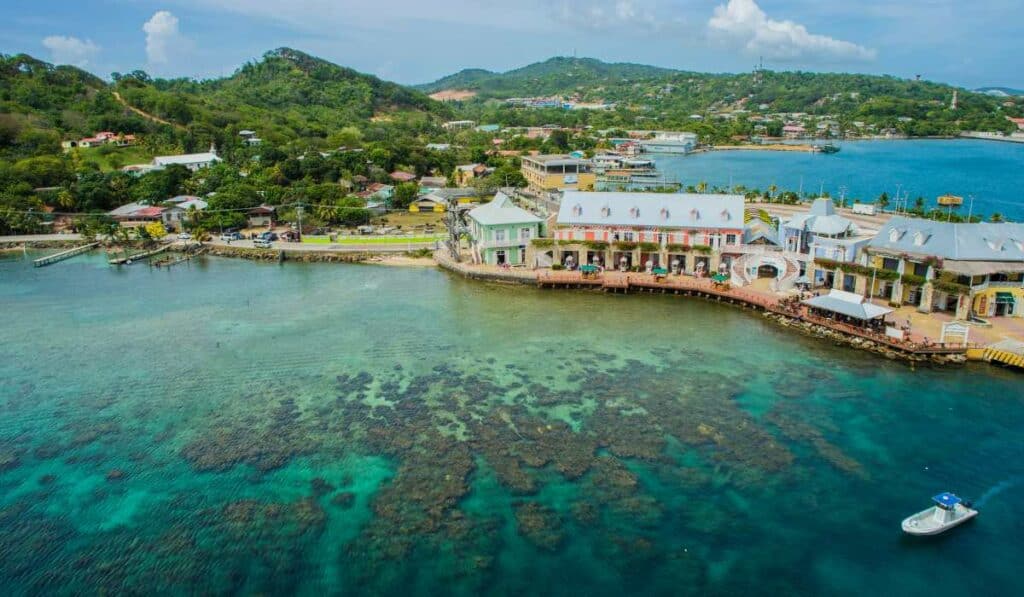
The weather conditions in Honduras play a significant role in determining the ideal time to go scuba diving. Tropical warmth, balmy waters, and sunlit days make for perfect scuba diving conditions in Honduras at certain times of the year.
Average Water Temperature
Honduras boasts an average water temperature ranging from 78°F (25°C) to 84°F (29°C), making it comfortable for divers throughout most of the year. The warmest months are typically from May to September, with cooler temperatures between December and February.
Rainy Season vs Dry Season
The country experiences two primary seasons: the rainy season and the dry season. The rainy season typically lasts from May until November, with heavier rainfall occurring on the mainland compared to coastal areas like Roatan or Utila. During this period, visibility may be reduced due to increased sedimentation caused by rainwater runoff.
- Dry Season: Generally runs from December through April; offers better visibility and calmer sea conditions perfect for scuba diving adventures.
- Rainy Season: Takes place between May and November; expect occasional showers but still possible to dive during this time as long as you’re prepared for potential changes in visibility or currents.
Hurricane Season Considerations
In addition to seasonal variations, keep in mind that Honduras is also susceptible to hurricanes during the Atlantic hurricane season which spans June through November. While direct hits are rare (National Hurricane Center), it’s essential to stay updated on weather forecasts and plan accordingly.
Best Time for Scuba Diving in Honduras
Taking into account the factors mentioned above, the best time to go scuba diving in Honduras is during the dry season, particularly from January through April. During these months, you can expect better visibility, calmer sea conditions, and a lower likelihood of encountering adverse weather events like hurricanes or tropical storms.
In summary, while scuba diving in Honduras is possible year-round with its warm waters and tropical climate, planning your trip during the dry season will ensure optimal underwater conditions for an unforgettable experience exploring this Central American paradise.
Key Takeaway:
The weather conditions in Honduras play a significant role in determining the ideal time to go scuba diving. Optimal conditions for scuba diving are typically found during the dry season, particularly January through April; however, it is important to stay informed of forecasts due to Honduras’ vulnerability to hurricanes from June until November.
FAQs About A Guide To Scuba Diving in Honduras
Conclusion
WHAT ARE THE 5 MOST IMPORTANT RULES OF SCUBA DIVING?
The five most important rules of scuba diving include:
1. Never hold your breath: Always breathe continuously to avoid lung overexpansion injuries.
2. Buddy system: Dive with a partner and maintain communication throughout the dive.
3 . Monitor air supply and depth regularly: Keep track of remaining air in your tank and don’t exceed safe depths for your certification level.
4 . Ascend slowly and perform safety stops: Prevent decompression sickness by ascending at a rate no faster than 30 feet per minute, with safety stops as needed.
5 . Plan your dive and follow the plan: Plan each dive according to conditions, skill levels, equipment, and objectives. Stick to the plan during the dive.
Is Honduras known for scuba diving?
Honduras is indeed known for its excellent scuba diving opportunities. The Bay Islands – Roatan, Utila, and Guanaja – offer some of Central America’s best underwater experiences.
With diverse marine life, healthy coral reefs, shipwrecks, and cave systems like Coco View Wall, it attracts divers from around the world seeking pristine waters and abundant aquatic wildlife. (source)
What is the 1 3 rule in scuba diving?
The “1/3 Rule” in a cave or technical wreck dives refers to dividing gas supply into three parts – one-third for entering (penetration), one-third for exiting (return), and one-third as a reserve for emergencies. This rule ensures divers have enough air to safely return from their dive while accounting for unforeseen circumstances. (source)
What is the golden rule of scuba diving?
The Golden Rule of scuba diving is “Never hold your breath.” Holding your breath can lead to lung overexpansion injuries, such as arterial gas embolism or pneumothorax.
Always breathe continuously and slowly during dives, allowing air to flow in and out without interruption.
Scuba diving in Honduras is a must-do for any adventurous traveler. From the stunning coral reefs to the diverse marine life, there are plenty of reasons why this Central American country should be on your scuba diving bucket list. Before you dive in, make sure to familiarize yourself with the rules and regulations, best locations, costs, safety tips, necessary gear, and weather conditions.
During your underwater exploration of Honduras’ Caribbean Sea or Bay Islands waters, you’ll have an opportunity to see vibrant tropical fish species such as parrotfish and angelfish as well as larger creatures like nurse sharks and eagle rays. It’s no surprise that Honduras’ aquatic depths are so attractive, drawing divers from all over to experience its beauty.

